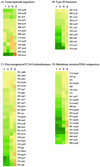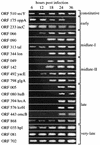Global stage-specific gene regulation during the developmental cycle of Chlamydia trachomatis
- PMID: 12730178
- PMCID: PMC154084
- DOI: 10.1128/JB.185.10.3179-3189.2003
Global stage-specific gene regulation during the developmental cycle of Chlamydia trachomatis
Abstract
Distinct morphological changes associated with the complex development cycle of the obligate intracellular bacterial pathogen Chlamydia trachomatis have been historically well characterized by microscopy. A number of temporally regulated genes have been characterized previously, suggesting that the chlamydial developmental cycle is regulated at the transcriptional level. This hypothesis was tested by microarray analysis in which the entire C. trachomatis genome was analyzed, providing a comprehensive assessment of global gene regulation throughout the chlamydial developmental cycle. Seven temporally cohesive gene clusters were identified, with 22% (189 genes) of the genome differentially expressed during the developmental cycle. The correlation of these gene clusters with hallmark morphological events of the chlamydial developmental cycle suggests three global stage-specific networks of gene regulation.
Figures



Similar articles
-
Initial Characterization of the Two ClpP Paralogs of Chlamydia trachomatis Suggests Unique Functionality for Each.J Bacteriol. 2018 Dec 20;201(2):e00635-18. doi: 10.1128/JB.00635-18. Print 2019 Jan 15. J Bacteriol. 2018. PMID: 30396899 Free PMC article.
-
Three temporal classes of gene expression during the Chlamydia trachomatis developmental cycle.Mol Microbiol. 2000 Aug;37(4):913-25. doi: 10.1046/j.1365-2958.2000.02057.x. Mol Microbiol. 2000. PMID: 10972811
-
Genomic transcriptional profiling of the developmental cycle of Chlamydia trachomatis.Proc Natl Acad Sci U S A. 2003 Jul 8;100(14):8478-83. doi: 10.1073/pnas.1331135100. Epub 2003 Jun 18. Proc Natl Acad Sci U S A. 2003. PMID: 12815105 Free PMC article.
-
The chlamydial developmental cycle.FEMS Microbiol Rev. 2005 Nov;29(5):949-59. doi: 10.1016/j.femsre.2005.03.002. FEMS Microbiol Rev. 2005. PMID: 16043254 Review.
-
Chlamydial persistence: beyond the biphasic paradigm.Infect Immun. 2004 Apr;72(4):1843-55. doi: 10.1128/IAI.72.4.1843-1855.2004. Infect Immun. 2004. PMID: 15039303 Free PMC article. Review. No abstract available.
Cited by
-
Chlamydial type III secretion system is encoded on ten operons preceded by sigma 70-like promoter elements.J Bacteriol. 2007 Jan;189(1):198-206. doi: 10.1128/JB.01034-06. Epub 2006 Oct 20. J Bacteriol. 2007. PMID: 17056752 Free PMC article.
-
Structural and ligand binding analyses of the periplasmic sensor domain of RsbU in Chlamydia trachomatis support a role in TCA cycle regulation.Mol Microbiol. 2020 Jan;113(1):68-88. doi: 10.1111/mmi.14401. Epub 2019 Nov 7. Mol Microbiol. 2020. PMID: 31637787 Free PMC article.
-
Diversity of σ66-Specific Promoters Contributes to Regulation of Developmental Gene Expression in Chlamydia trachomatis.J Bacteriol. 2023 Jan 26;205(1):e0031022. doi: 10.1128/jb.00310-22. Epub 2023 Jan 4. J Bacteriol. 2023. PMID: 36598485 Free PMC article.
-
DNA supercoiling-dependent gene regulation in Chlamydia.J Bacteriol. 2008 Oct;190(19):6419-27. doi: 10.1128/JB.00431-08. Epub 2008 Jul 25. J Bacteriol. 2008. PMID: 18658267 Free PMC article.
-
Overexpressing the ClpC AAA+ unfoldase accelerates developmental cycle progression in Chlamydia trachomatis.mBio. 2025 Jan 8;16(1):e0287024. doi: 10.1128/mbio.02870-24. Epub 2024 Nov 22. mBio. 2025. PMID: 39576108 Free PMC article.
References
-
- Arfin, S. M., A. D. Long, E. T. Ito, L. Tolleri, M. M. Riehle, E. S. Paegle, and G. W. Hatfield. 2000. Global gene expression profiling in Escherichia coli K-12. The effects of integration host factor. J. Biol. Chem. 275:29672-29684. - PubMed
-
- Bannantine, J. P., R. S. Griffiths, W. Viratyosin, W. J. Brown, and D. D. Rockey. 2000. A secondary structure motif predictive of protein localization to the chlamydial inclusion membrane. Cell. Microbiol. 2:35-47. - PubMed
-
- Bannantine, J. P., D. D. Rockey, and T. Hackstadt. 1998. Tandem genes of Chlamydia psittaci that encode proteins localized to the inclusion membrane. Mol. Microbiol. 28:1017-1026. - PubMed
-
- Barry, C. E., 3rd, S. F. Hayes, and T. Hackstadt. 1992. Nucleoid condensation in Escherichia coli that express a chlamydial histone homolog. Science 256:377-379. - PubMed
Publication types
MeSH terms
Grants and funding
LinkOut - more resources
Full Text Sources

